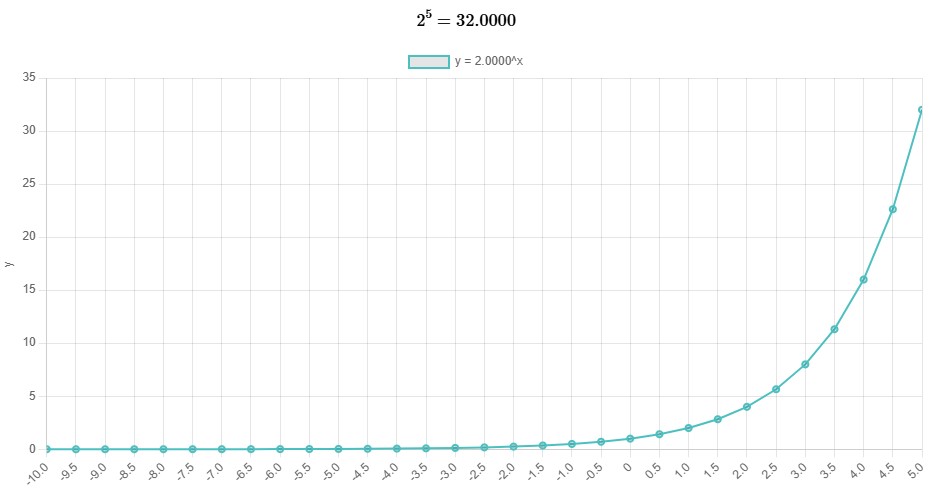Powerful Exponent Calculator
About the Exponent Calculator
The Exponent Calculator is a powerful tool designed to simplify complex calculations involving exponents. Whether you’re a student, professional, or just someone who needs to perform quick mathematical operations, this calculator has got you covered.
Understanding Exponents
An exponent is a mathematical notation used to indicate the number of times a base number is multiplied by itself. In the expression \(a^b\), \(a\) is the base and \(b\) is the exponent. For example, in \(2^3\), the base is 2 and the exponent is 3, which means 2 is multiplied by itself 3 times: \(2 \times 2 \times 2 = 8\).
Examples of Exponents
Let’s look at some examples to better understand how exponents work:
- \(2^3 = 2 \times 2 \times 2 = 8\)
- \(5^2 = 5 \times 5 = 25\)
- \(3^4 = 3 \times 3 \times 3 \times 3 = 81\)
Negative Exponents
A negative exponent indicates that the base is on the denominator of a fraction. For example, \(2^{-3}\) is equivalent to \(\frac{1}{2^3}\) or \(\frac{1}{8}\). Here are some examples:
- \(2^{-3} = \frac{1}{2^3} = \frac{1}{8}\)
- \(5^{-2} = \frac{1}{5^2} = \frac{1}{25}\)
- \(3^{-4} = \frac{1}{3^4} = \frac{1}{81}\)
Fractional Exponents
A fractional exponent represents a root of the base. For example, \(a^{1/2}\) is the square root of \(a\), and \(a^{1/3}\) is the cube root of \(a\). Here are some examples:
- \(8^{1/3} = \sqrt[3]{8} = 2\)
- \(16^{1/2} = \sqrt{16} = 4\)
- \(27^{1/3} = \sqrt[3]{27} = 3\)
Combining Negative and Fractional Exponents
Exponents can be both negative and fractional. For example, \(8^{-1/3}\) is equivalent to \(\frac{1}{8^{1/3}}\) or \(\frac{1}{2}\). Here are some examples:
- \(8^{-1/3} = \frac{1}{8^{1/3}} = \frac{1}{2}\)
- \(16^{-1/2} = \frac{1}{16^{1/2}} = \frac{1}{4}\)
- \(27^{-1/3} = \frac{1}{27^{1/3}} = \frac{1}{3}\)
Properties of Exponents
Exponents follow several important properties that make calculations easier. Here are some key properties:
- Product of Powers Property: \(a^m \cdot a^n = a^{m+n}\)
- Quotient of Powers Property: \(\frac{a^m}{a^n} = a^{m-n}\)
- Power of a Power Property: \((a^m)^n = a^{m \cdot n}\)
- Power of a Product Property: \((ab)^m = a^m \cdot b^m\)
- Power of a Quotient Property: \(\left(\frac{a}{b}\right)^m = \frac{a^m}{b^m}\)
- Zero Exponent Property: \(a^0 = 1\) (for \(a \neq 0\))
- Negative Exponent Property: \(a^{-n} = \frac{1}{a^n}\)
Complex Examples
Let’s explore some more complex examples that involve multiple properties of exponents:
- \(2^3 \cdot 2^4 = 2^{3+4} = 2^7 = 128\)
- \(\frac{3^5}{3^2} = 3^{5-2} = 3^3 = 27\)
- \((2^3)^2 = 2^{3 \cdot 2} = 2^6 = 64\)
- \((2 \cdot 3)^2 = 2^2 \cdot 3^2 = 4 \cdot 9 = 36\)
- \(\left(\frac{2}{3}\right)^3 = \frac{2^3}{3^3} = \frac{8}{27}\)
- \(5^0 = 1\)
- \(4^{-2} = \frac{1}{4^2} = \frac{1}{16}\)
How to Use the Exponent Calculator
Using the Exponent Calculator is straightforward. Simply enter the base and exponent values, and the calculator will compute the result for you. You can also enter the result and one of the other values to solve for the missing variable.

Follow us on Facebook for more updates.
Contact us at office@calculator-convert.com
Benefits of Using the Exponent Calculator
The Exponent Calculator offers several benefits. It saves time by performing calculations quickly and accurately. It also helps reduce errors that can occur when performing manual calculations. Additionally, it provides a visual representation of the calculation through a chart, making it easier to understand the relationship between the base, exponent, and result.
Applications of the Exponent Calculator
The Exponent Calculator can be used in various fields, including mathematics, physics, engineering, and finance. It is particularly useful for solving problems related to exponential growth and decay, compound interest, and logarithmic functions.
Exponential Growth and Decay
Exponential growth and decay are common in many natural phenomena. The formula for exponential growth or decay is given by:
\[ A = P \cdot e^{rt} \]where \(A\) is the final amount, \(P\) is the initial amount, \(r\) is the growth or decay rate, and \(t\) is time.
For example, if an initial investment of \$1000 grows at an annual rate of 5% for 10 years, the final amount can be calculated as:
\[ A = 1000 \cdot e^{0.05 \cdot 10} \approx 1648.72 \]Compound Interest
Compound interest is calculated using the formula:
\[ A = P \left(1 + \frac{r}{n}\right)^{nt} \]where \(A\) is the final amount, \(P\) is the principal amount, \(r\) is the annual interest rate, \(n\) is the number of times interest is compounded per year, and \(t\) is the time in years.
For example, if \$1000 is invested at an annual interest rate of 5%, compounded quarterly for 10 years, the final amount can be calculated as:
\[ A = 1000 \left(1 + \frac{0.05}{4}\right)^{4 \cdot 10} \approx 1647.01 \]Logarithmic Functions
Logarithmic functions are the inverse of exponential functions. The logarithm of a number \(x\) to a base \(b\) is the exponent to which \(b\) must be raised to get \(x\). It is denoted as \(\log_b(x)\).
For example, \(\log_2(8) = 3\) because \(2^3 = 8\).
Logarithms are useful in solving equations involving exponents. For example, to solve \(2^x = 16\), we can take the logarithm of both sides:
\[ \log_2(2^x) = \log_2(16) \] \[ x = \log_2(16) = 4 \]Conclusion
In conclusion, the Exponent Calculator is an essential tool for anyone who needs to perform calculations involving exponents. Its user-friendly interface and accurate results make it a valuable resource for both students and professionals. Try it out today and experience the power of the Exponent Calculator!
